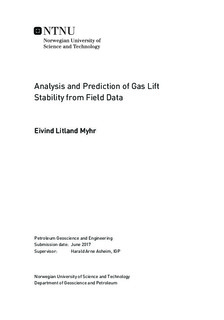Analysis and Prediction of Gas Lift Stability from Field Data
Master thesis
Permanent lenke
http://hdl.handle.net/11250/2452864Utgivelsesdato
2017Metadata
Vis full innførselSamlinger
Sammendrag
Producing oil wells on continuous gas lift may under certain operating conditions develop flow instabilities. Prediction on beforehand may enable prevention by design and operational changes. Stability criteria exist, but gas lift wells predicted stable by such criteria often turn out unstable in practice.
A theoretical gas lift model has been tested against field data and the stability of a gas lift well investigated. Based on existing stability criteria, the new model pretends to improve the prediction power by considering the outflow variations explicitly. Incorporating the outflow in the model is physically reasonable and seems to improve prediction capabilities in certain cases. Dynamic production characteristics in the well have been explored in detail, and the model response compared with measured dynamics. The dynamic response of the model is predicted using numerical simulation as well as an analytical solution.
Analysis of the data showed the well might develop severe oscillations. These appear to be initiated by the combination of varying density of the produced fluid mixture and disturbances in the gas delivery system. The proposed model predicts the well stable for all stationary production periods examined. In periods of flow instability in field data, the model prediction is in disagreement with observed response.
A parametric sensitivity study has been performed and demonstrated the model is capable of capturing the effect of main design and reservoir parameters on stability. When the outflow response is excluded from the model, the prediction capabilities seems to be reduced.
